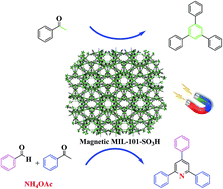Magnetic MIL-101-SO3H: a highly efficient bifunctional nanocatalyst for the synthesis of 1,3,5-triarylbenzenes and 2,4,6-triaryl pyridines†
Abstract
A magnetic MIL-101-SO3H was synthesized and successfully used as a highly active nanocatalyst for the synthesis of 1,3,5-triarylbenzenes and 2,4,6-triaryl pyridines. The prepared nanocatalyst was characterized by Fourier transform infrared spectroscopy, scanning electron microscopy, energy-dispersive X-ray and X-ray powder diffraction. It is found that the catalyst can be easily separated from the reaction mixture by an external magnetic field and recycled several times without a significant loss of activity.


 Please wait while we load your content...
Please wait while we load your content...